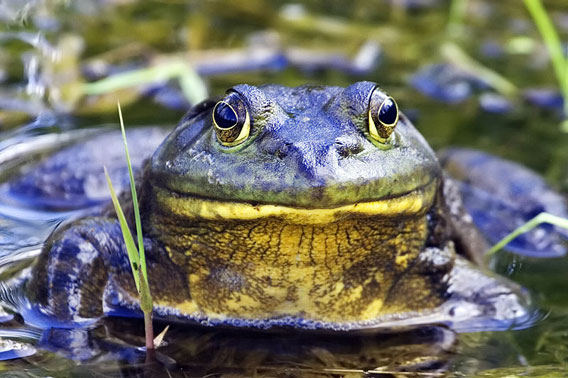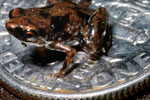
Invasive American bullfrog in British Colombia. Photo by: Alan D. Wils.
Santa Cruz, California has become the first city in the U.S. to ban the importation, sale, release, and possession of the American bullfrog (Rana catesbeiana). Found throughout Eastern and Central U.S., the frogs have become an invasive threat to wildlife in the western U.S. states and Canada.
“This legislation is a huge step forward in protecting Santa Cruz native wildlife and should get the ball rolling in other cities and states where bullfrogs are a problem,” said Kerry Kriger, founder of Save The Frogs, a Santa Cruz-based NGO that requested the legislation. “California imports three million bullfrogs into the state each year, for use as frog legs and for pets. They eat our native frogs and whatever else fits in their mouth.”
The city council unanimously agreed to the ban after a request from the Water Department. A report noted that most American bullfrogs in Santa Cruz come from pet shops.
Farmed worldwide, American bullfrogs have become an invasive problem in 15 countries to date. In addition to devouring native wildlife, Kriger says the invasive species may also carry a insidious killer: the chytrid fungus, an amphibian disease that has decimated populations worldwide. Although the American bullfrog appears to be immune to the disease most frogs are not. In fact, such western U.S. species like the mountain yellow-legged frog (Rana muscosa), listed as Endangered by the IUCN Red List, and the boreal toad (Bufo boreas boreas) are thought to be suffering from the killer fungus.
“Most of [the American bullfrogs] come from frog farms in Taiwan and China and are infected by the chytrid fungus, which has driven 100 amphibian species to complete extinction in recent decades,” Kriger adds.
Related articles
Frog perfume? Madagascar frogs communicate via airborne pheromones
(01/25/2012) Researchers have found that some frogs in Madagascar communicate by more than just sound and sight: they create distinct airborne pheromones, which are secreted chemicals used for communicating with others. A paper published in Angewandte Chemie International Edition relates that some male members of the Mantellinae family in Madagascar use large glands on their inner thighs to produce airborne pheromones. Interestingly, the pheromones are structurally similar to those produced by insects. Scientists have identified frogs producing water-borne pheromones before, but this is the first instance of airborne.
New frog trumps miniscule fish for title of ‘world’s smallest vertebrate’

(01/12/2012) How small can you be and still have a spine? Scientists are continually surprised by the answer. Researchers have discovered a new species of frog in Papua New Guinea that is smaller than many insects and dwarfed by a dime. The frog trumps the previously known smallest vertebrate—a tiny fish—by nearly 1 millimeter.
(01/03/2012) The chytrid fungus, which is responsible for the collapse of numerous amphibian populations as well as the extinction of entire species, has been located for the first time in India, according to a paper in Herpetological Review. Researchers took swabs of frog in the genus Indirana in the Western Ghats and found the killer fungus known as chytridiomycosis.







